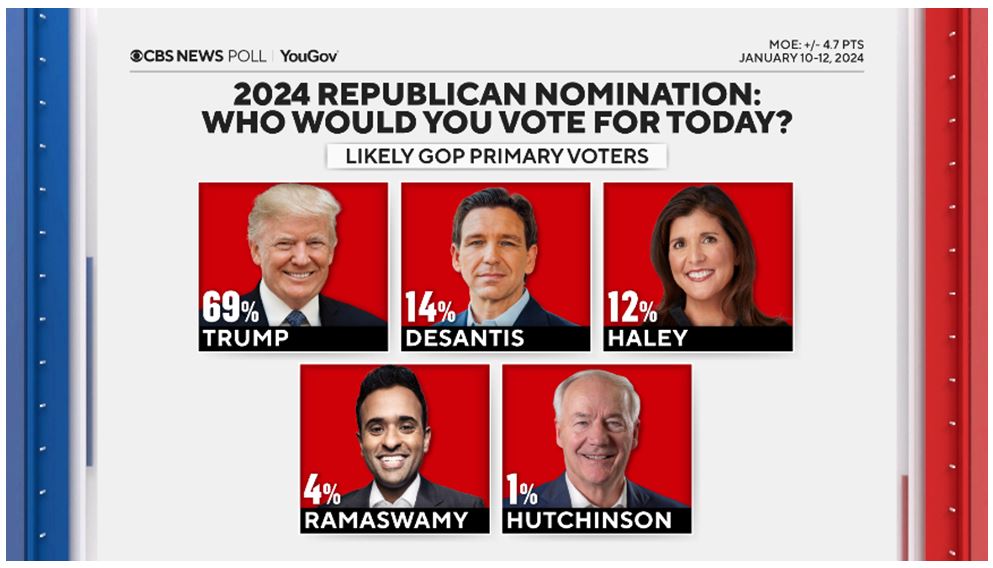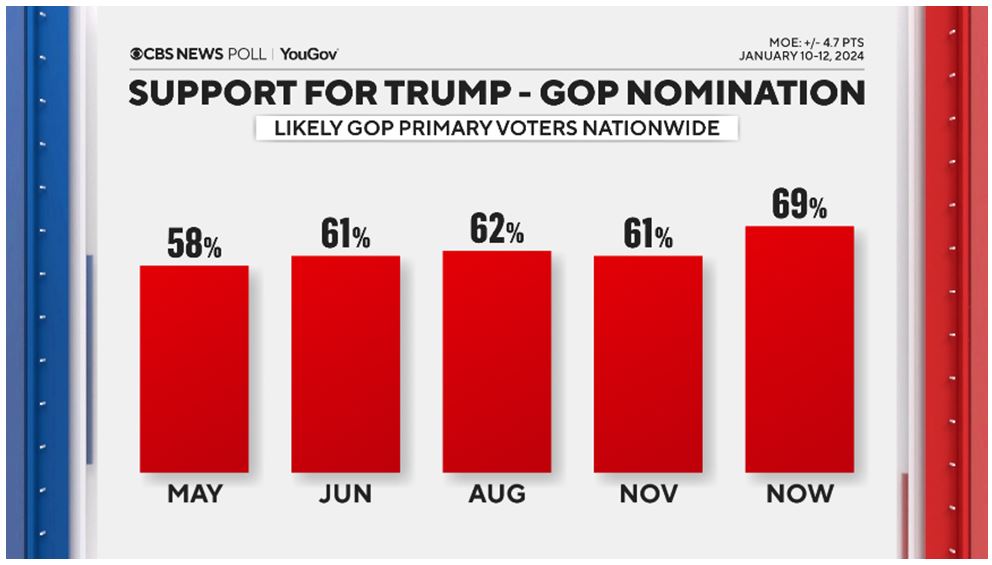by Bryan Perry
January 17, 2024
The market stage is set for what looks to be a very bumpy ride ahead, as a series of fluid situations are ramping towards inflection points that could bring about some abrupt fallout and ramifications regarding the U.S. economy, in the midst of a key presidential election year, plus new trends within our society.
We’re only halfway through January, but there is already plenty to chew on for the year ahead.
First, the widening out of the war in the Middle East has become more interesting after some 130 attacks on U.S. targets finally generated a response. Houthi attacks on shipping in the Red Sea risked reigniting global supply chain disruptions, so the Biden administration finally responded against Houthi rebels in Yemen. One can surmise that the timing of the U.S. response at the beginning of an election year plays to the historical pattern that no U.S. incumbent president has ever lost an election during an overseas war.


Over in China this past weekend, voters in Taiwan elected the Democratic Progressive Party (DPP) to another four years, seizing victory in the national election. The DPP won 40% of the votes over two rival parties. The win marks a third term for the DPP and stokes tensions between mainland China and the island nation as to whether the use of military force by China may be the next step to gain Beijing’s desired reunification and control of Taiwan – and what the U.S. response would be in such a scenario.

In a third potential war front, the appetite for continued financial support for Ukraine is waning. The latest survey by The Associated Press and the National Opinion Research Center showed only 48% of those interviewed supported providing more weapons to Kyiv, 29% opposed it and 22% had no opinion.
In a similar survey last May, 60% of Americans supported supplying weapons to Ukraine, so there is a growing sentiment that the U.S. has done its part and that Europe and NATO need to up their role. At this point, Russia controls Crimea and the Donbas region, and both Russia and Ukraine suffer troop attrition.
In the domestic political race, the U.S. Supreme Court says it will hear a historic case to determine whether Donald Trump can run for president. The justices agreed to take on Mr. Trump’s appeal against a decision by Colorado to remove him from that state’s 2024 ballot. The case will be heard in February and the ruling will apply nationwide. Mr. Trump is currently in the midst of three separate trails in New York, Washington D.C. and Atlanta over financial allegations, the events of January 6, and 2020 election interference allegations.
The outcomes of all three trials are up in the air, but odds are that the Supreme Court trial will decide in Trump’s favor. If so, we’ll likely see another close presidential election in November. According to The Hill/Decision Desk HQ’s national polling average, Trump and Biden remain neck-and-neck in a hypothetical head-to-head general election rematch. Trump has 44.3 percent of support, while Biden has 43.1 percent.


A serious situation that is getting less press is that the federal debt continues to soar at a pace that has the potential to bring real downside pressure to the dollar and upside pressure to the long end of the yield curve if buyers demand more yield for the rising risks of creditworthiness. Reuters said last Thursday:
“The U.S. federal government posted a December deficit of $129 billion, up $44 billion or 52% from a year earlier as outlays rose while receipts fell from December 2022 levels that were swelled by pandemic-deferred tax payments, the U.S. Treasury Department said on Thursday. The Treasury said that outlays for December rose 3% to $559 billion, a December record, partly as a result of higher Social Security outlays and interest on the public debt. Receipts for the month fell 6% to $429 billion.” – Reuters Jan. 11, 2024
China’s economy is likely facing years of stagnation unless major market reforms occur, thereby weighing heavily on world output. China is currently experiencing a property crisis, weak consumer spending, and high youth unemployment. “The 2024 challenge for the Chinese economy will not be GDP growth — that will likely be above 4.5%,” said Derek Scissors, senior fellow at the American Enterprise Institute. “The challenge will be that the only direction from there is down.”
Logan Wright, director of China markets research at Rhodium Group, agreed, saying: “The slowdown in China’s economy is structural, caused by the end of an unprecedented expansion in credit and investment over the past decade.” The country’s financial system simply won’t be able to generate the same levels of credit growth that it has in previous years, he said, therefore Beijing will have far less control over the direction of its economy than it has in the past. The Shanghai Composite Index reflects this economic deterioration, as it is about to test pandemic lows.

Graphs are for illustrative and discussion purposes only. Please read important disclosures at the end of this commentary.
Thankfully, the U.S. economy and U.S. stock market are on more solid footing, with the CPI running at 3.4% and trending lower, generating expected interest rate cuts early this year. The CME FedWatch Tool has a 77% probability of a quarter-point cut taking place at the March 20 FOMC meeting following last week’s release of the CPI and PPI data. The employment market has shown itself to be resilient, with the focus of investor attention squarely on fourth quarter earnings season, which is just getting underway.
At this point, only 6% of S&P 500 companies have reported fourth quarter results. Of those companies, 76% have reported positive EPS surprise and 55% have reported positive revenue surprises (source: factset.com). The big money center banks failed to impress when they reported last Friday, but the market took that in stride. Still, investors should brace for a choppy market going forward, impacted by the above-noted situations and a slowing domestic economy, where forecasting future growth is elusive.
The bullish momentum of the last 10 weeks will be tested when the blue-chip technology companies post their numbers and guidance. They bore the torch in 2023, and in my view, will do so again in 2024.
All content above represents the opinion of Bryan Perry of Navellier & Associates, Inc.
Also In This Issue
A Look Ahead by Louis Navellier
Why the Fed Follows the PCE, not the CPI or PPI
Income Mail by Bryan Perry
Bracing For More Volatility Ahead
Growth Mail by Gary Alexander
Why the Fed Lost Over $116 Billion in 2023
Global Mail by Ivan Martchev
U.S. M2 Money Supply is Still Shrinking
Sector Spotlight by Jason Bodner
How Long Can This Market Stay Overbought?
View Full Archive
Read Past Issues Here

Bryan Perry
SENIOR DIRECTOR
Bryan Perry is a Senior Director with Navellier Private Client Group, advising and facilitating high net worth investors in the pursuit of their financial goals.
Bryan’s financial services career spanning the past three decades includes over 20 years of wealth management experience with Wall Street firms that include Bear Stearns, Lehman Brothers and Paine Webber, working with both retail and institutional clients. Bryan earned a B.A. in Political Science from Virginia Polytechnic Institute & State University and currently holds a Series 65 license. All content of “Income Mail” represents the opinion of Bryan Perry
Important Disclosures:
Although information in these reports has been obtained from and is based upon sources that Navellier believes to be reliable, Navellier does not guarantee its accuracy and it may be incomplete or condensed. All opinions and estimates constitute Navellier’s judgment as of the date the report was created and are subject to change without notice. These reports are for informational purposes only and are not a solicitation for the purchase or sale of a security. Any decision to purchase securities mentioned in these reports must take into account existing public information on such securities or any registered prospectus.To the extent permitted by law, neither Navellier & Associates, Inc., nor any of its affiliates, agents, or service providers assumes any liability or responsibility nor owes any duty of care for any consequences of any person acting or refraining to act in reliance on the information contained in this communication or for any decision based on it.
Past performance is no indication of future results. Investment in securities involves significant risk and has the potential for partial or complete loss of funds invested. It should not be assumed that any securities recommendations made by Navellier. in the future will be profitable or equal the performance of securities made in this report. Dividend payments are not guaranteed. The amount of a dividend payment, if any, can vary over time and issuers may reduce dividends paid on securities in the event of a recession or adverse event affecting a specific industry or issuer.
None of the stock information, data, and company information presented herein constitutes a recommendation by Navellier or a solicitation to buy or sell any securities. Any specific securities identified and described do not represent all of the securities purchased, sold, or recommended for advisory clients. The holdings identified do not represent all of the securities purchased, sold, or recommended for advisory clients and the reader should not assume that investments in the securities identified and discussed were or will be profitable.
Information presented is general information that does not take into account your individual circumstances, financial situation, or needs, nor does it present a personalized recommendation to you. Individual stocks presented may not be suitable for every investor. Investment in securities involves significant risk and has the potential for partial or complete loss of funds invested. Investment in fixed income securities has the potential for the investment return and principal value of an investment to fluctuate so that an investor’s holdings, when redeemed, may be worth less than their original cost.
One cannot invest directly in an index. Index is unmanaged and index performance does not reflect deduction of fees, expenses, or taxes. Presentation of Index data does not reflect a belief by Navellier that any stock index constitutes an investment alternative to any Navellier equity strategy or is necessarily comparable to such strategies. Among the most important differences between the Indices and Navellier strategies are that the Navellier equity strategies may (1) incur material management fees, (2) concentrate its investments in relatively few stocks, industries, or sectors, (3) have significantly greater trading activity and related costs, and (4) be significantly more or less volatile than the Indices.
ETF Risk: We may invest in exchange traded funds (“ETFs”) and some of our investment strategies are generally fully invested in ETFs. Like traditional mutual funds, ETFs charge asset-based fees, but they generally do not charge initial sales charges or redemption fees and investors typically pay only customary brokerage fees to buy and sell ETF shares. The fees and costs charged by ETFs held in client accounts will not be deducted from the compensation the client pays Navellier. ETF prices can fluctuate up or down, and a client account could lose money investing in an ETF if the prices of the securities owned by the ETF go down. ETFs are subject to additional risks:
- ETF shares may trade above or below their net asset value;
- An active trading market for an ETF’s shares may not develop or be maintained;
- The value of an ETF may be more volatile than the underlying portfolio of securities the ETF is designed to track;
- The cost of owning shares of the ETF may exceed those a client would incur by directly investing in the underlying securities; and
- Trading of an ETF’s shares may be halted if the listing exchange’s officials deem it appropriate, the shares are delisted from the exchange, or the activation of market-wide “circuit breakers” (which are tied to large decreases in stock prices) halts stock trading generally.
Grader Disclosures: Investment in equity strategies involves substantial risk and has the potential for partial or complete loss of funds invested. The sample portfolio and any accompanying charts are for informational purposes only and are not to be construed as a solicitation to buy or sell any financial instrument and should not be relied upon as the sole factor in an investment making decision. As a matter of normal and important disclosures to you, as a potential investor, please consider the following: The performance presented is not based on any actual securities trading, portfolio, or accounts, and the reported performance of the A, B, C, D, and F portfolios (collectively the “model portfolios”) should be considered mere “paper” or pro forma performance results based on Navellier’s research.
Investors evaluating any of Navellier & Associates, Inc.’s, (or its affiliates’) Investment Products must not use any information presented here, including the performance figures of the model portfolios, in their evaluation of any Navellier Investment Products. Navellier Investment Products include the firm’s mutual funds and managed accounts. The model portfolios, charts, and other information presented do not represent actual funded trades and are not actual funded portfolios. There are material differences between Navellier Investment Products’ portfolios and the model portfolios, research, and performance figures presented here. The model portfolios and the research results (1) may contain stocks or ETFs that are illiquid and difficult to trade; (2) may contain stock or ETF holdings materially different from actual funded Navellier Investment Product portfolios; (3) include the reinvestment of all dividends and other earnings, estimated trading costs, commissions, or management fees; and, (4) may not reflect prices obtained in an actual funded Navellier Investment Product portfolio. For these and other reasons, the reported performances of model portfolios do not reflect the performance results of Navellier’s actually funded and traded Investment Products. In most cases, Navellier’s Investment Products have materially lower performance results than the performances of the model portfolios presented.
This report contains statements that are, or may be considered to be, forward-looking statements. All statements that are not historical facts, including statements about our beliefs or expectations, are “forward-looking statements” within the meaning of The U.S. Private Securities Litigation Reform Act of 1995. These statements may be identified by such forward-looking terminology as “expect,” “estimate,” “plan,” “intend,” “believe,” “anticipate,” “may,” “will,” “should,” “could,” “continue,” “project,” or similar statements or variations of such terms. Our forward-looking statements are based on a series of expectations, assumptions, and projections, are not guarantees of future results or performance, and involve substantial risks and uncertainty as described in Form ADV Part 2A of our filing with the Securities and Exchange Commission (SEC), which is available at www.adviserinfo.sec.gov or by requesting a copy by emailing info@navellier.com. All of our forward-looking statements are as of the date of this report only. We can give no assurance that such expectations or forward-looking statements will prove to be correct. Actual results may differ materially. You are urged to carefully consider all such factors.
FEDERAL TAX ADVICE DISCLAIMER: As required by U.S. Treasury Regulations, you are informed that, to the extent this presentation includes any federal tax advice, the presentation is not written by Navellier to be used, and cannot be used, for the purpose of avoiding federal tax penalties. Navellier does not advise on any income tax requirements or issues. Use of any information presented by Navellier is for general information only and does not represent tax advice either express or implied. You are encouraged to seek professional tax advice for income tax questions and assistance.
IMPORTANT NEWSLETTER DISCLOSURE:The hypothetical performance results for investment newsletters that are authored or edited by Louis Navellier, including Louis Navellier’s Growth Investor, Louis Navellier’s Breakthrough Stocks, Louis Navellier’s Accelerated Profits, and Louis Navellier’s Platinum Club, are not based on any actual securities trading, portfolio, or accounts, and the newsletters’ reported hypothetical performances should be considered mere “paper” or proforma hypothetical performance results and are not actual performance of real world trades. Navellier & Associates, Inc. does not have any relation to or affiliation with the owner of these newsletters. There are material differences between Navellier Investment Products’ portfolios and the InvestorPlace Media, LLC newsletter portfolios authored by Louis Navellier. The InvestorPlace Media, LLC newsletters contain hypothetical performance that do not include transaction costs, advisory fees, or other fees a client might incur if actual investments and trades were being made by an investor. As a result, newsletter performance should not be used to evaluate Navellier Investment services which are separate and different from the newsletters. The owner of the newsletters is InvestorPlace Media, LLC and any questions concerning the newsletters, including any newsletter advertising or hypothetical Newsletter performance claims, (which are calculated solely by Investor Place Media and not Navellier) should be referred to InvestorPlace Media, LLC at (800) 718-8289.
Please note that Navellier & Associates and the Navellier Private Client Group are managed completely independent of the newsletters owned and published by InvestorPlace Media, LLC and written and edited by Louis Navellier, and investment performance of the newsletters should in no way be considered indicative of potential future investment performance for any Navellier & Associates separately managed account portfolio. Potential investors should consult with their financial advisor before investing in any Navellier Investment Product.
Navellier claims compliance with Global Investment Performance Standards (GIPS). To receive a complete list and descriptions of Navellier’s composites and/or a presentation that adheres to the GIPS standards, please contact Navellier or click here. It should not be assumed that any securities recommendations made by Navellier & Associates, Inc. in the future will be profitable or equal the performance of securities made in this report.
FactSet Disclosure: Navellier does not independently calculate the statistical information included in the attached report. The calculation and the information are provided by FactSet, a company not related to Navellier. Although information contained in the report has been obtained from FactSet and is based on sources Navellier believes to be reliable, Navellier does not guarantee its accuracy, and it may be incomplete or condensed. The report and the related FactSet sourced information are provided on an “as is” basis. The user assumes the entire risk of any use made of this information. Investors should consider the report as only a single factor in making their investment decision. The report is for informational purposes only and is not intended as an offer or solicitation for the purchase or sale of a security. FactSet sourced information is the exclusive property of FactSet. Without prior written permission of FactSet, this information may not be reproduced, disseminated or used to create any financial products. All indices are unmanaged and performance of the indices include reinvestment of dividends and interest income, unless otherwise noted, are not illustrative of any particular investment and an investment cannot be made in any index. Past performance is no guarantee of future results.
